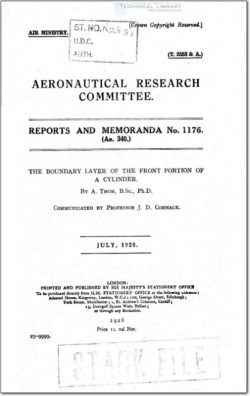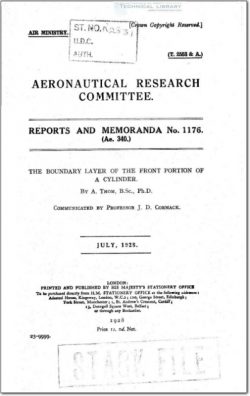ARC-RM-1176

- Version
- 151 Downloads
- 3.75 MB File Size
- 1 File Count
- June 16, 2016 Create Date
- June 16, 2016 Last Updated
The Boundary Layer of the Front Portion of a Cylinder

A large amount of information is now available
regarding the flow of water or air past a cylinder placed across the
stream so far as the behaviour of the main body of the fluid is
concerned ; but the conditions in the layer close to the surface of
the cylinder seem to be largely unknown. Accordingly it seemed
advisable to explore the velocity, etc., close to the surface. This
paper consists of two parts, first, a description of experiments on
the boundary layer carried out in the Summer of 1927 in the James
Watt Engineering Laboratories, University of Glasgow, and second,
a theory of the boundary layer over the front portion“ of the cylinder
based on Prandtl’s simplified boundary layer equations as given by
Bairstow in his illuminating paper on Skin Friction to the Royal
Aeronautical Society in January, 1925.
The cylinder used for these experiments was of
brass 45 inches in diameter, turned and ground true. The resulting
surface was smooth but was not polished. The cylinder extended
across the wind channel which is approximately 2 ft. square. As
it is the boundary layer which is under consideration the relative
largeness of the cylinder compared to the channel dimensions can
hardly affect the results. Since the boundary layer theory assumes
a knowledge of the pressures and velocities outside the skin the
pressure distribution was first obtained by drilling a small hole in
the central section of the cylinder. As the cylinder could be rotated
to any position a comparison of the pressure in this hole with that
in a similar hole in a plate on the channel wall, for various positions
of the hole, gave the required pressure distribution. This was done
for channel speeds of 123 and 36 ft./sec.
Thefresults are given in Table 2 and shown plotted in fig. 1.
No corrections have been applied to these figures and subsequent
experiment showed that they are referred to a pressure which. is
below the undisturbed static pressure in the channel.
| File | Action |
|---|---|
| ARC-RM-1176 The Boundary Layer of the Front Portion of a Cylinder.pdf | Download |
Comment On This Post